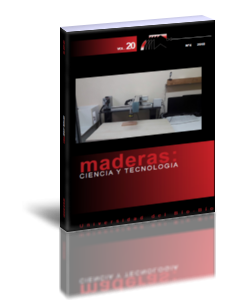Determinación inversa de la conductividad térmica en madera de Pinus radiata
Keywords:
Drying curves, heat transfer coefficient, inverse problem, radiata pine, specific heat, thermal properties, wood dryingAbstract
Laboratory scale experiments are performed in order to characterize the artificial wood drying of Pinus radiata at conventional temperatures and accelerated temperatures. The experimental data allow to determine the wood thermal conductivity through inverse methodology. The comparative analysis shows that the implementation of the developed inverse methodology is consistent with information available in the specialized literature; which means increased thermal conductivities with increased humidity and temperature, whose values oscillate between 0,34 and 0,56 (W/m K) to moisture variations between 22% and 64%; and temperatures between 70°C and 90°C, respectively.
Downloads
References
Ananías, R.A.; Lastra, J.; Salvo, L.; Contreras, H.; Barría, C.; Peredo, M. 2010. Estudio exploratorio de la variabilidad radial y apical del tamaño y frecuencia de los canales resiníferos en pino radiata. Maderas-Ciencia y Tecnología 12(2): 135-142.
Beard, J.; Rosen, H.; Adesanya, B. 1983. Temperature, Distributions and Heat Transfer During the Drying of Lumber. Drying Technology 1(1): 117-140.
Cai, L. 2005. Determination of Diffusion Coefficients for Sub-alpine fir. Wood Science Technology 39: 153-162.
Cai, L.; Garrahan, P. 2006. Inverse Determination of Thermal Conductivity in Frozen Lumber. Wood Science Technology 40: 665-672.
Czajkowski, L.; Olek, W.; Weres, J.; Guzenda, R. 2016. Thermal Properties of Wood-Based Panels: Thermal Conductivity Identification with Inverse Modeling. Eur J Wood Prod74: 577-584.
Derdour, L.; Desmorieux, H.; Andrieu, J. 2007. The Critical Moisture Content (c.m.c.) and the Internal Moisture Content Profile During the Constant Drying rate Period. Drying Technology 16(3), 813-824.
Diaz-vaz; J.E.; Fernandez, A.; Valenzuela L.; Torres, M. 2007. Madera de compresión en Pinus radiata: I Características anatómicas. Maderas-Cienc Tecnol 9(1):29-43.
Diaz-vaz, J.E.; Ananías, R.A.; Rodriguez, S.; Torres, M.; Fernández, A.; Valenzuela, L. 2009. Compression wood in Pinus radiata II: Density and chemical composition. Maderas-Cienc Tecnol 11(2):139-151.
Haque, M.; Langrish, T. 2001. Stack-wide Effects in the Modeling of Solar Kilns for Drying Timber. Drying Technology 19(1): 99-114.
Haque, M. 2007. Simulation of Temperature and Moisture Content Profiles in a Pinus radiata Board During High-Temperature Drying. Drying Technology 25: 547-555.
INFOR 2016. La Industria del Aserrío. Boletín Estadístico N° 155. Instituto Forestal, Santiago-Chile.
Instituto Nacional de Normalización. NCh968.Of86: Madera - Selección, Obtención y Acondicionamiento de Muestras y Probetas para la Determinación de Propiedades Físicas y Mecánicas. Santiago, Chile, 1986.
Liu, J.; Simpson, W.; Verrill, S. 2001. An Inverse Moisture Diffusion Algorithm for the Determination of Diffusion Coefficient. Drying Technology 19(8): 1555-1568.
Luikov, A. V. 1966. Heat and mass transfer in capillary porous bodies. Pergamon Press, Oxford. pp 522.
Nijdam, J.; Langrish, T.; Keey, R. 2000. A High-Temperature Drying Model for Softwood Timber. Chemical Engineering Science 55: 3585-3598.
Özisik, M.; Orlande, H. 2000. Inverse Heat Transfer. Taylor & Francis. 330pp.
Pang, S. 1996. Moisture Content Gradient in a Softwood Board Drying: Simulation From a 2-D Model and Measurement. Wood Science and Technology 30: 165-178.
Patankar, S. V. 1980. Numerical Heat Transfer and Fluid Flow. Hemisphere Publishing Corporation, N. Y. 197pp.
Pérez-Peña, N.; Valenzuela, L.; Díaz-Vaz, J.E.; Ananías, R.A. 2011. Predicción del contenido de humedad de equilibrio de la madera en función del peso específico de la pared celular y variables ambientales. Maderas-Cienc Tecnol 13(3):253-266.
Salinas, C.; Ananías, R. A.; Ruminot, P. 2008. Modelación fenomenológica de las curvas de secado por alta temperatura de pino radiata. Maderas-Cienc Tecnol 10(3): 207-217.
Salinas, C.; Chávez, C.; Ananías, R.A.; Elustondo. D. 2015. Unidimensional simulation of drying stresses in radiata pine wood. Drying Technology 33 (8):996-1005.
Vay, O.; De Borst, K.; Hansmann, C.; Teischinger, A.; Muller, U. 2015. Thermal conductivity of wood at angles to the principal anatomical directions. Wood Sci Technol 49(3): 577-589.
Versteeg, H. K.; Malalasekera, W. 1995. An Introduction to Computational Fluid Dynamics. Longman Scientific & Technical. 257pp.
Zhao, J.; Fu, Z.; Jia, X.; Cai, Y. 2015. Inverse Determination of Thermal Conductivity in Lumber based on Genetic Algorithms. Holzforschung 70: 1-7.
Whittaker, S. 1977. Simultaneous heat, mass, and momentum transfer in porous media: A theory of drying. Advances in Heat Transfer 13: 119- 203.
Zhang, J.; Miao, P.; Zhong, D.; Liu, L. 2014. Mathematical modeling of drying of Masson pine lumber and its asymmetrical moisture content profile. Holzforschung 68(3), 313–321.
Zhao, J.; Fu, Z.; Jia, X.; Cai, Y. 2016. Modeling Conventional Drying of Wood: Inclusion of a moving evaporation Interface. Drying Technology 34(5): 530-538.
Zheng, S.; Song, K.; Zhao, J.; Dong, C. 2016. Inverse Estimation of Effective Moisture Diffusivity in Lumber During Drying Using Genetic Algorithms. BioResources 11(4): 8226-8238.

































